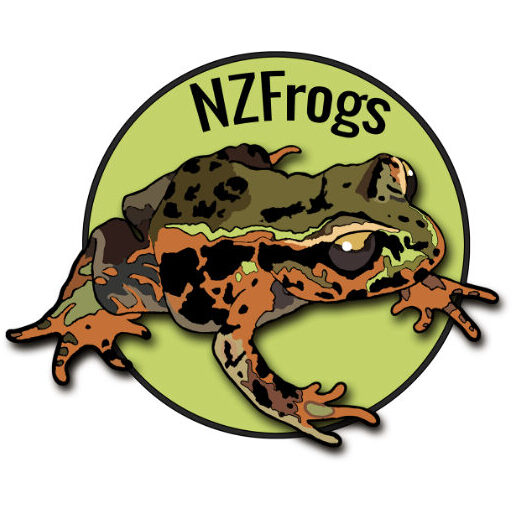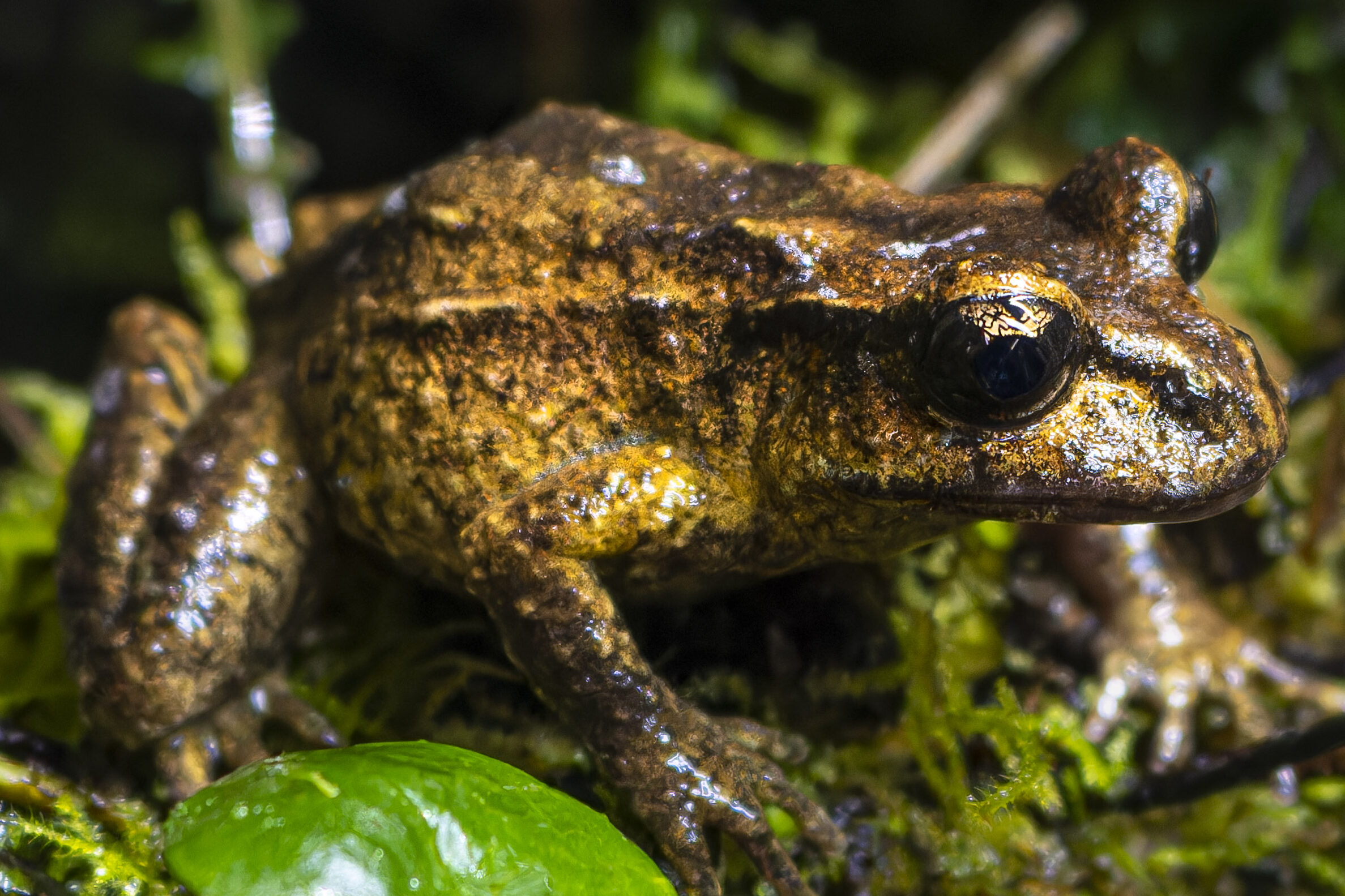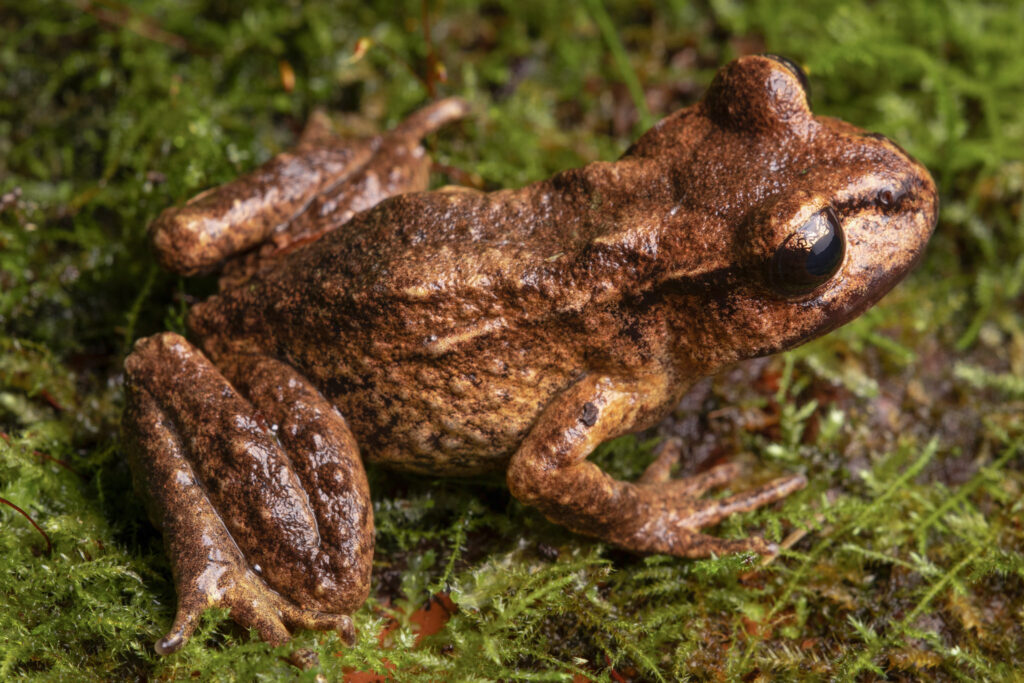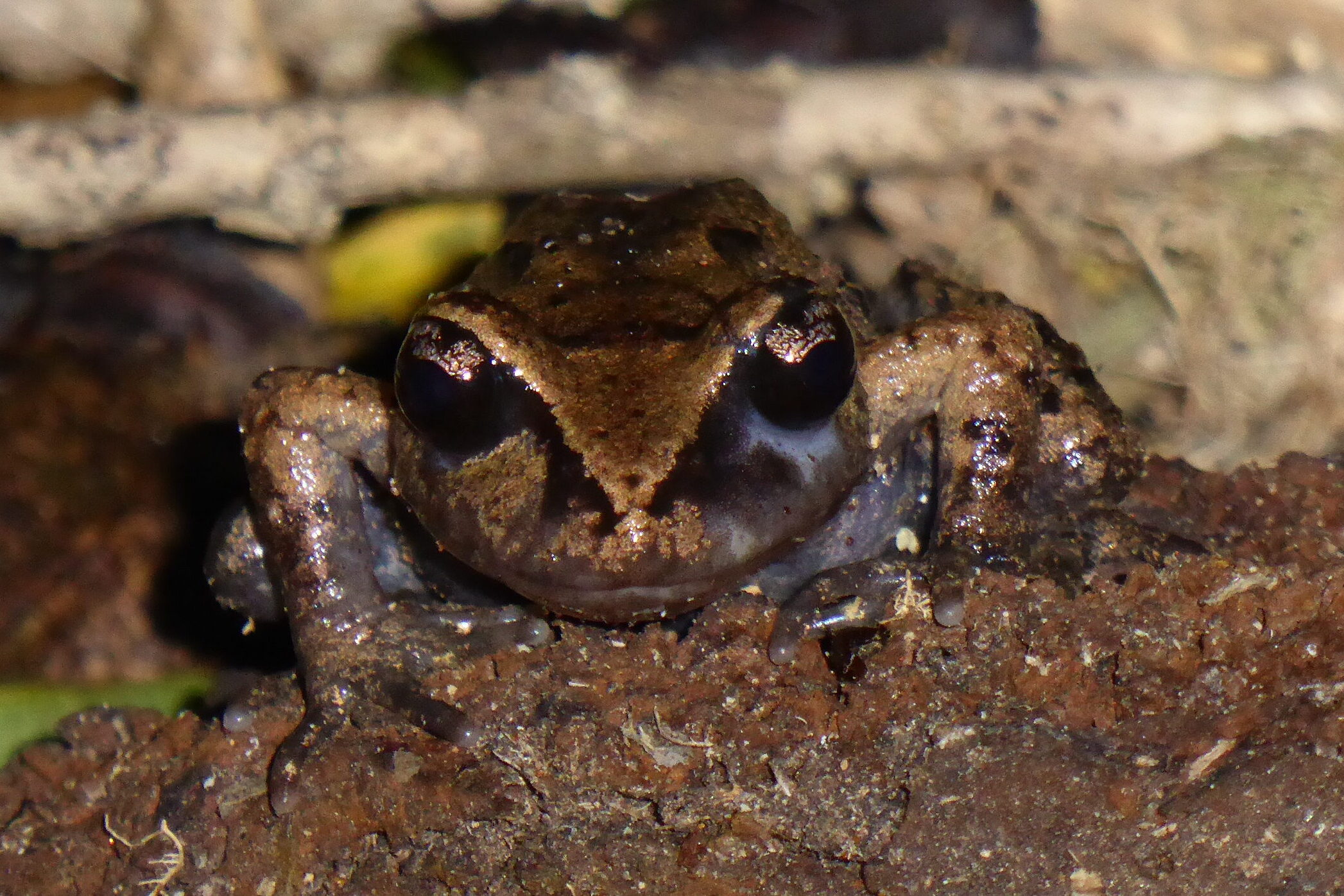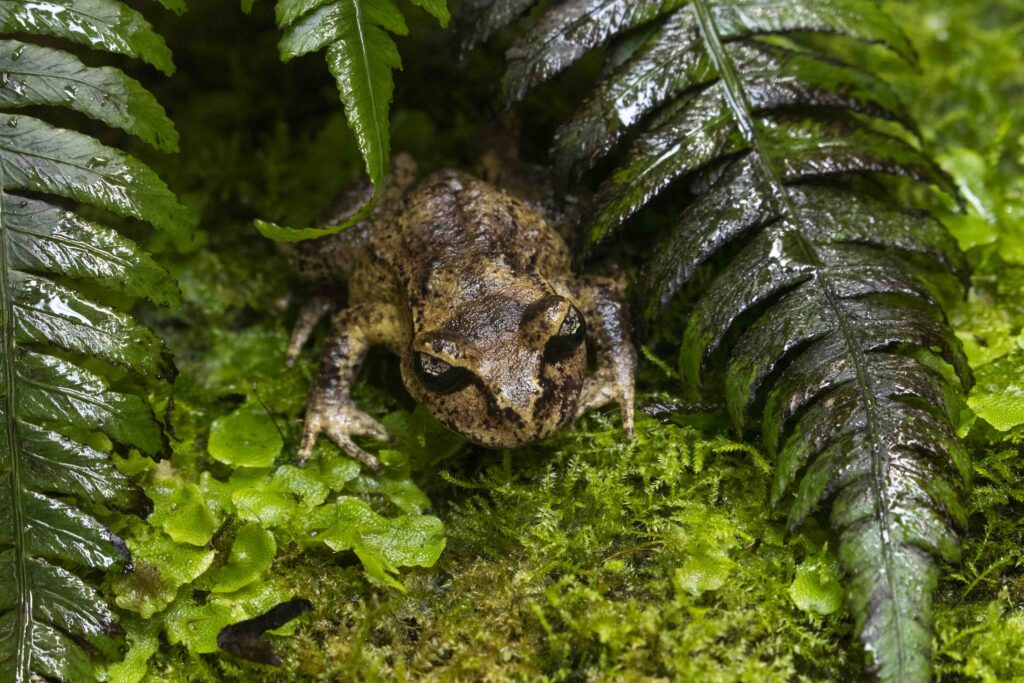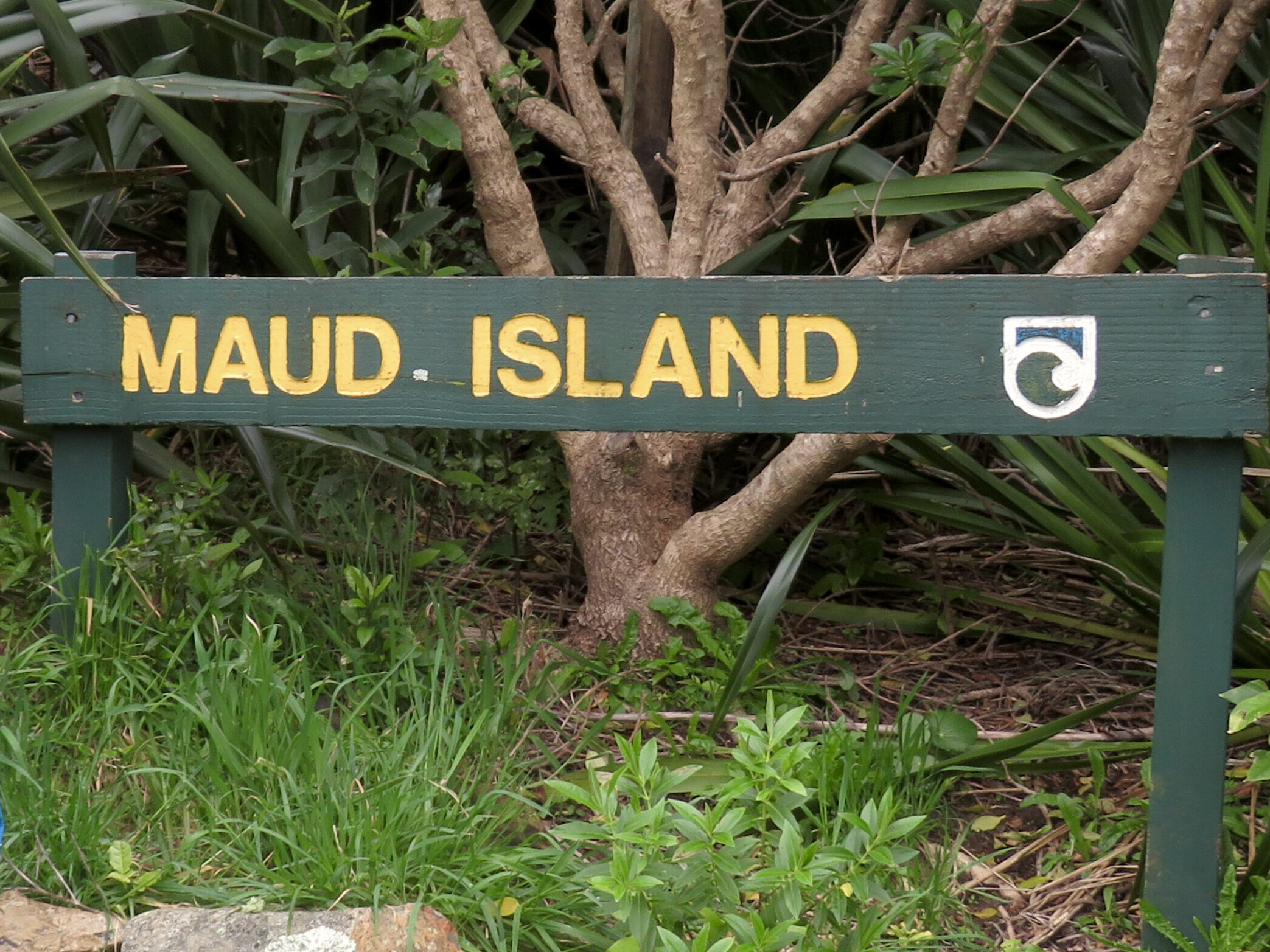Threat status
2017 NZ Conservation Status: Threatened – Nationally vulnerable
2015 IUCN Red list of Threatened Species: Vulnerable
Description
The nocturnal Hamilton’s Frog (Leiopelma hamiltoni) is the largest of the three native species of frog found in New Zealand. Hamilton’s frogs are varied shades of light to dark brown, with darker blotches and/or speckle patterning. They have a glandular ridge line which runs backwards from the tip of their snout (nose) and up over their eye.
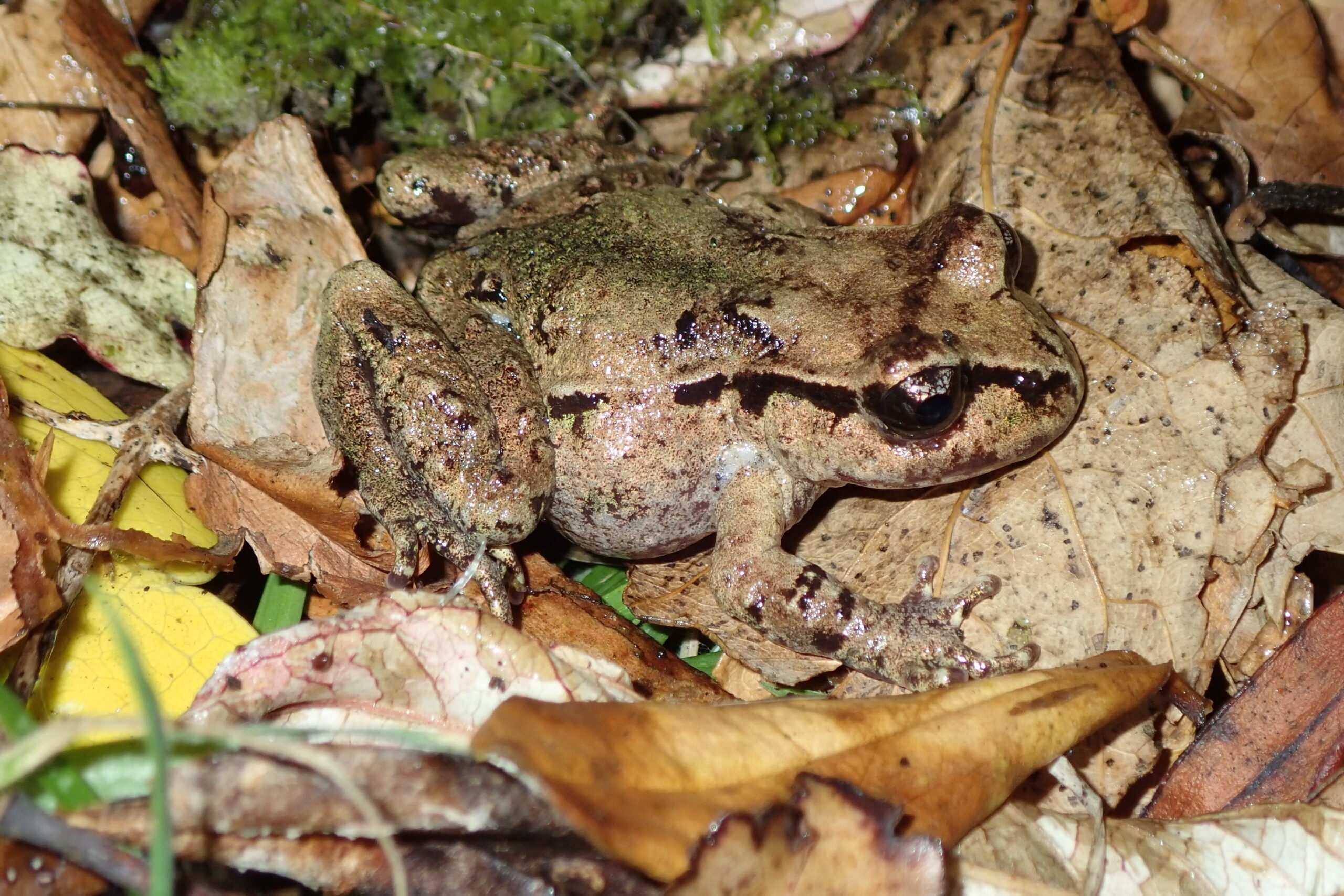
Like all New Zealand native Leiopelma frogs, they have no tympanum (eardrum) and do not croak like is expected of a “typical” frog. As a terrestrial species, they also lack webbing on both the front and back feet. Hamilton’s frogs are monomorphic (i.e. both males and females look alike) and therefore very difficult to sex these frogs in the field. They can live for up to 45 years.
How big are these frogs?
Frog body size is generally measured as snout to vent length (SVL). SVL is the distance from their snout (tip of their nose) to their vent (bottom). Male Hamilton’s frogs are the smaller of the two sexes with a SVL <43 mm, females can be slightly larger with SVL<52 mm.
Habitat
Hamilton’s frogs are a terrestrial species which inhabit native forest and rocky patches, away from streams or creeks. They are nocturnal but sometimes emerge on damp, misty days. Most often their days are spent hidden under stones, tree roots, or logs. Recently, it was discovered Hamilton’s frog also uses arboreal habitat. Individuals have high home range fidelity and generally do not stray >2 metres from a refuge site.There are only two natural remnant populations persisting on two offshore islands in the Marlborough Sounds, Takapourewa (Stephens Island) and Maud Island. Previously these populations were thought to be separate species but have since been synonymised. Because of Hamilton’s frog’s extremely restricted range, multiple conservation translocations have been made. The most successful translocation was to restored habitat in Boat Bay, Maud Island. 100 individuals were released in 1984 and now locally bred individuals outnumber the translocated frogs. Since then the DOC (The Department of Conservation) has translocated Hamilton’s frog to Motuara Island in 2001, Nukuwaiata in 2004 & 6 and Long Island in 2005 and Zealandia Ecosanctuary in 2006 & 12. These translocations, in particular Motuara Island, were successful and established the only mainland population at Zealandia
Breeding
Hamilton’s frogs have never been observed breeding in the wild. Hormone analysis of Hamilton’s frog urine suggests breeding may occur in the winter or early spring. However, retired Professor, Dr Ben Bell, has previously made some reproduction observations from an outdoor enclosure. He discovered that in captivity frogs lay 1-19 eggs in December in moist depressions under logs, rocks or vegetation. As in Archey’s frog, they exhibit parental care. Males brood eggs for 14-21 weeks until hatching. Eggs hatch tailed froglets which climb onto the dorsal surface of the male and continue their development.
Threats
Introduced Predators
Hamilton’s frog is the largest living native frog. Similar to the extinct Markham’s frog and Aurora frog, Hamilton’s frog is described as “robust” because of their larger size. It is likely that these more “robust” native frogs were severely impacted by kiore/rat predation. Hamilton’s Frog was extirpated (locally extinct) from the mainland before European colonisation of New Zealand. The introduction of mammalian predators is thought to be an especially large threat to Hamitlon’s frog given they only remain on predator free Islands, whereas the other two species have managed to survive in mainland areas where reduction and management of introduced mammalian predators is ongoing.
Disease
As for all native frogs, chytrid fungus likely poses a low risk to Hamilton’s frog populations. In experimental exposures to chytrid fungus Hamilton’s frogs were able to clear infection without any illness.
Habitat Disturbance
Habitat disturbance is not of concern for Hamilton’s frog as it is found only in conservation areas such as predator free islands, mainland sanctuaries and zoos.
Captive Populations
There is a captive population of Hamilton’s frogs located at the Christchurch Orana WIldlife Park, who are working hard to develop a captive breeding programme.
Here are some of the frogs which live at Orana Wildlife Park.

Comet
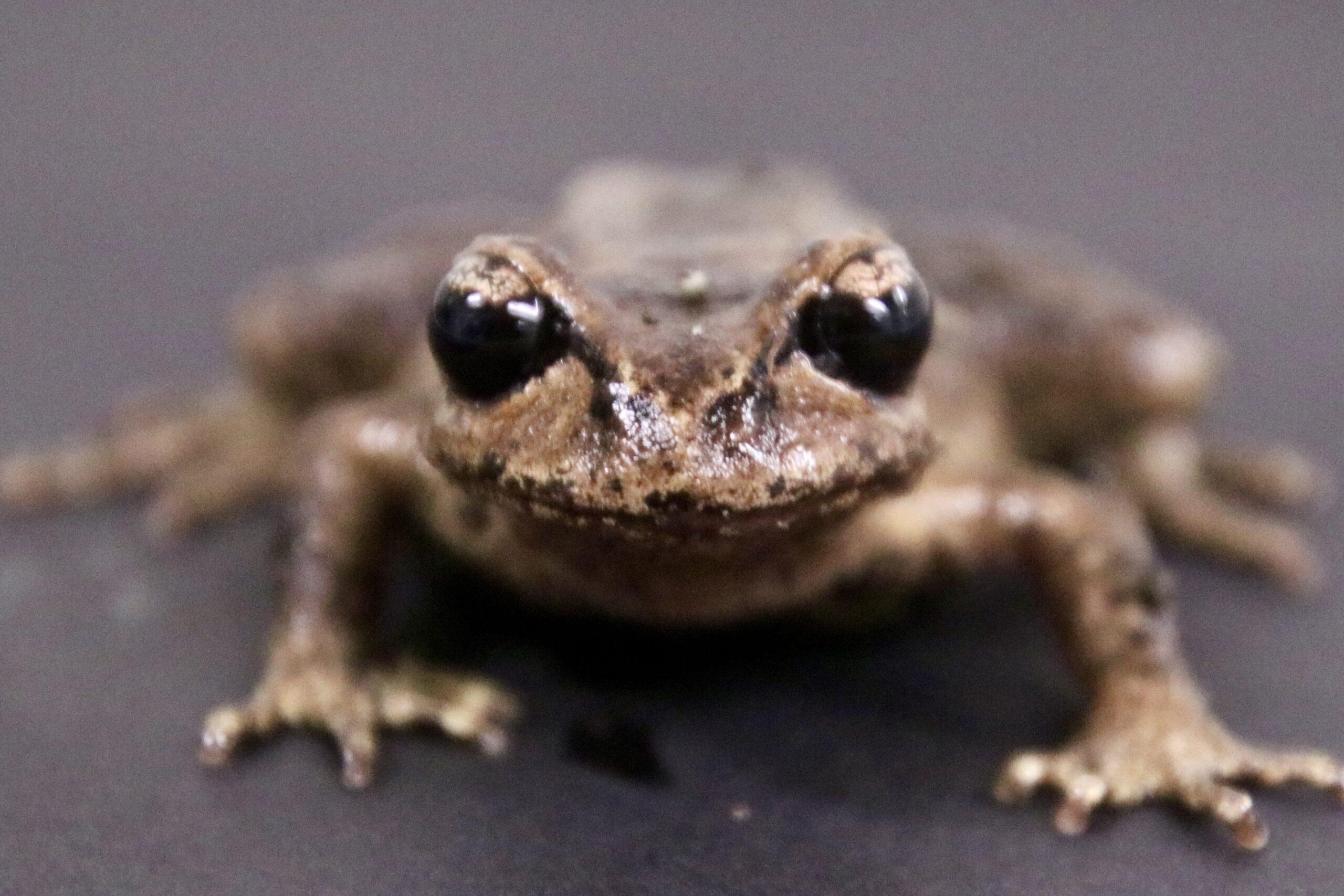
Freckles
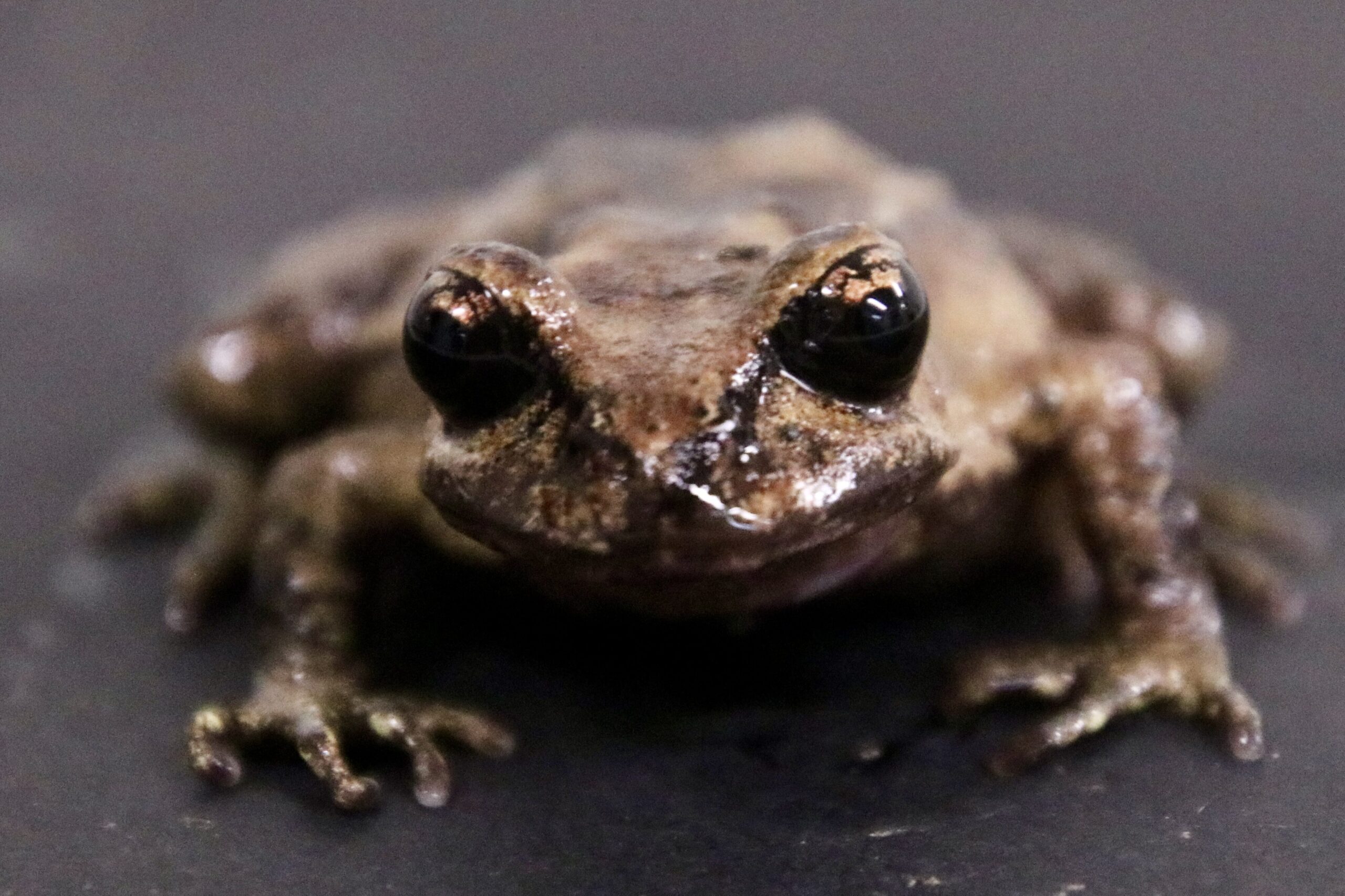
Moko
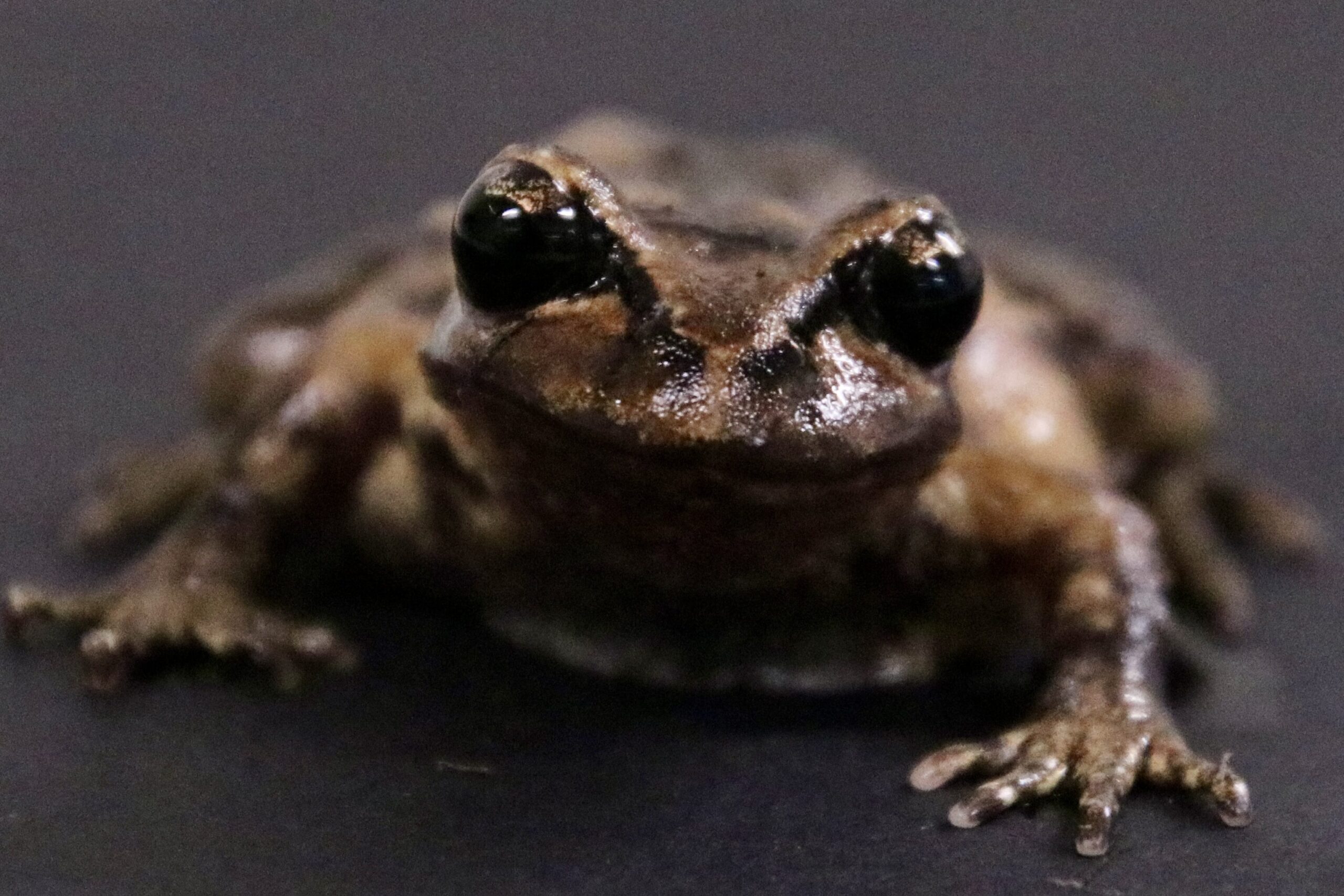
Tigger
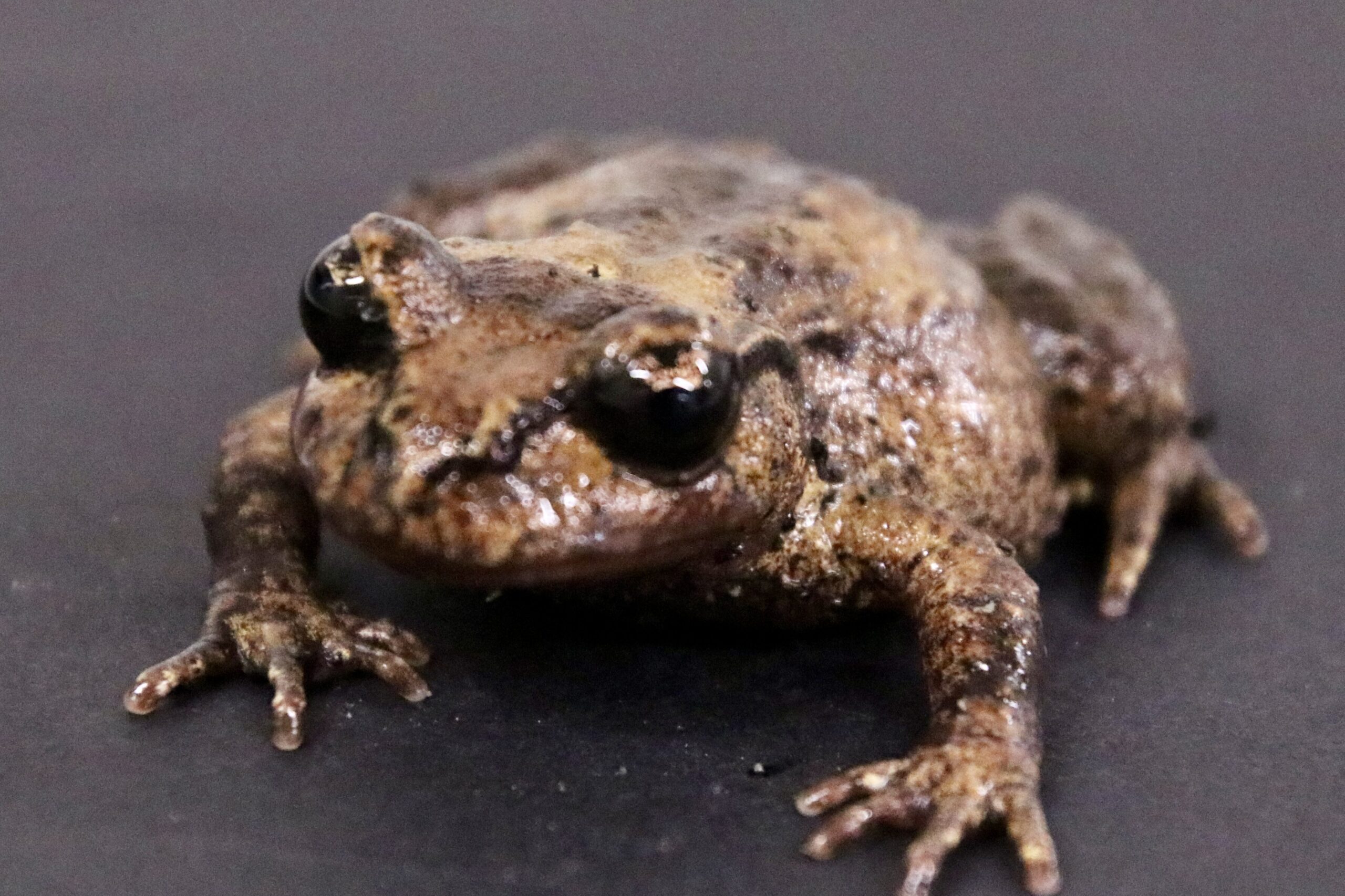
Terri

Blacky
Fossil record
New Zealand frogs have an extensive subfossil record. However, it is hard to determine the prehistoric range of Hamilton’s frog because their subfossils look very similar to those of Archey’s frog. Hamilton’s Frog was once spread across the North Western South Island to Punakaiki and throughout the Central North Island current research on this topic is ongoing.
References
Altobelli, J. T., Lamar, S. K., & Bishop, P. J. (2021). Archaic, terrestrial Hamilton’s frogs (Leiopelma hamiltoni) display arboreal behaviours. New Zealand Journal of Ecology, 45(2), 1-6.
Altobelli II, J. T. (2023). The spatial ecology of Hamilton’s frog, Leiopelma hamiltoni on Te Pākeka Maud Island (Doctoral dissertation, University of Otago).
Altobelli, J. T., Bishop, P. J., Dickinson, K. J., & Godfrey, S. S. (2023). Suitability of radio telemetry for monitoring two New Zealand frogs (Leiopelma archeyi and L. hamiltoni). New Zealand Journal of Ecology, 47(2), 3532.
Bell BD. (1978). Observations on the Ecology and Reproduction of the New Zealand Leiopelmid Frogs. Herpetologica. 34(4):340–354.
Bell, B. D., & Pledger, S. A. (2023). Post-metamorphic body growth and remarkable longevity in Archey’s frog and Hamilton’s frog in New Zealand. New Zealand Journal of Ecology, 47(2), A2.
Bishop, P. J., Daglish, L. A., Haigh, A., Marshall, L. J., Tocher, M., & McKenzie, K. L. (2013). Native frog (Leiopelma spp.) recovery plan, 2013-2018. Wellington: Publishing Team, Department of Conservation.
Burns RJ, et al,. (2018). Conservation status of New Zealand amphibians, 2017. Wellington: Publishing Team, Department of Conservation.
Easton, L. (2018). Taxonomy and genetic management of New Zealand’s Leiopelma frogs (Doctoral dissertation, University of Otago).
Easton, L. J., Rawlence, N. J., Worthy, T. H., Tennyson, A. J., Scofield, R. P., Easton, C. J., … & Bishop, P. J. (2018). Testing species limits of New Zealand’s leiopelmatid frogs through morphometric analyses. Zoological Journal of the Linnean Society, 183(2), 431-444.
Germano, J. M., Molinia, F. C., Bishop, P. J., Bell, B. D., & Cree, A. (2012). Urinary hormone metabolites identify sex and imply unexpected winter breeding in an endangered, subterranean-nesting frog. General and Comparative Endocrinology, 175(3), 464-472.
Karst, T. M., Lukis, K., & Bell, B. D. (2023). Translocation of Hamilton’s frog, Leiopelma hamiltoni, to a mainland sanctuary occupied by mice Mus musculus. New Zealand Journal of Ecology, 47(2), A11.
McCulloch A.R. (1919). A New Discoglossoid Frog from New Zealand. Transactions andProceedings of the Royal Society of New Zealand. 51:447–449
Ohmer, M. E., Herbert, S. M., Speare, R., & Bishop, P. J. (2013). Experimental exposure indicates the amphibian chytrid pathogen poses low risk to New Z ealand’s threatened endemic frogs. Animal Conservation, 16(4), 422-429.
Purdie, S. (2022). A naturalist’s guide to the reptiles & amphibians of New Zealand (pp. 154-155). John Beaufoy Publishing.
Worthy, T. H. (1987). Palaeoecological information concerning members of the frog genus Leiopelma: Leiopelmatidae in New Zealand. Journal of the Royal Society of New Zealand, 17(4), 409-420.
Wren, S., Bishop, P. J., Beauchamp, A. J., Bell, B. D., Bell, E., Cisternas, J., … & Germano, J. M. (2023). A review of New Zealand native frog translocations: lessons learned and future priorities. New Zealand Journal of Ecology, 47(2), A12.
